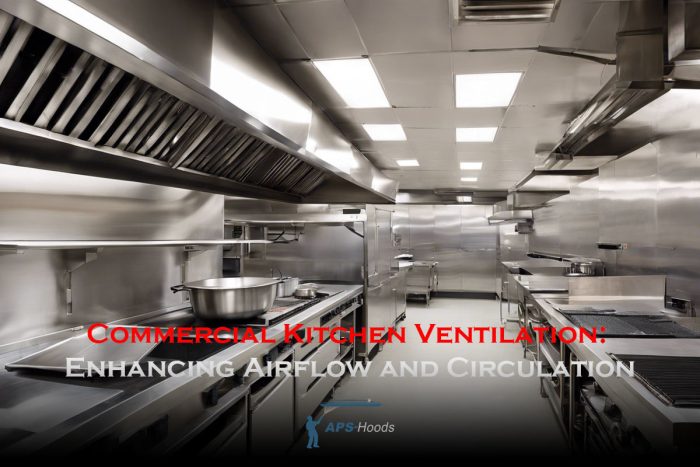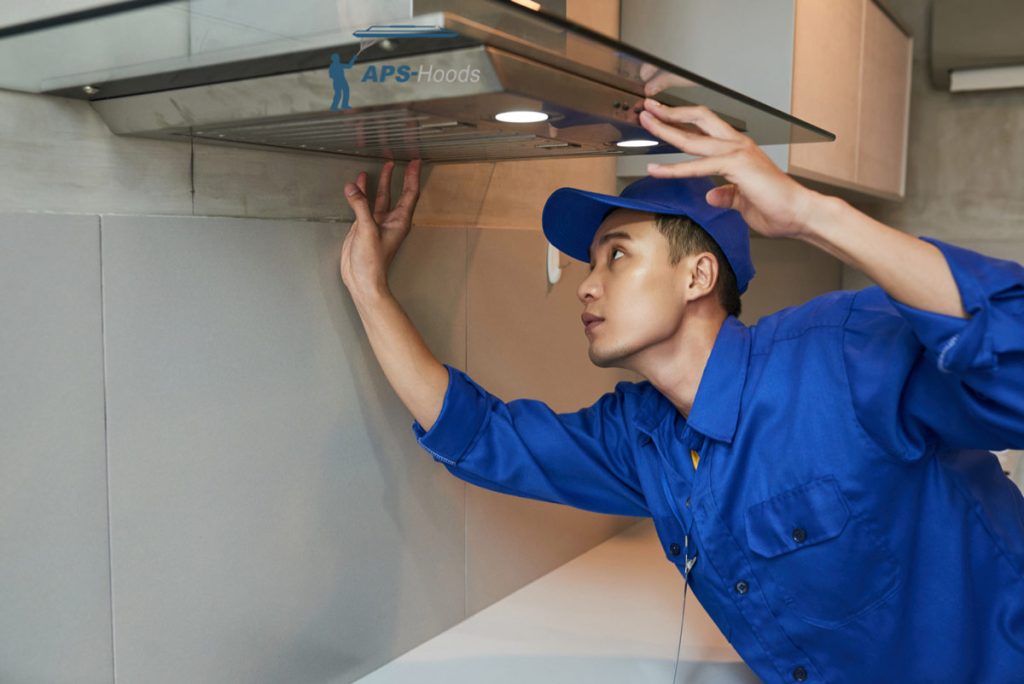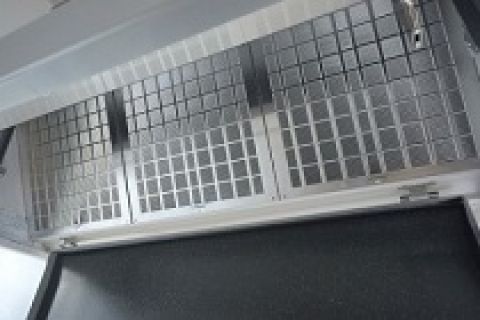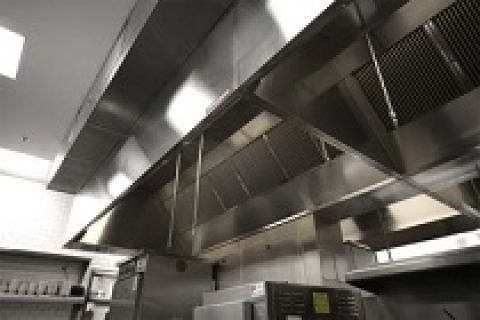Commercial Kitchen Ventilation: Enhancing Airflow and Circulation for Culinary Excellence

“The proof is in the pudding,” and in any bustling commercial food service, the kitchen is where the magic of mass culinary production happens. The setup, build, and upkeep of commercial kitchen ventilation systems are critical, as they deftly handle grease vapors, smells, airborne particles, moisture, and dangerous gasses like carbon monoxide. Therefore, ensuring these systems are in top condition is the secret ingredient to a successful and safe culinary operation.
In this article, we’ll uncover the secret ingredient to a successful and safe culinary operation: commercial kitchen ventilation. We’ll break down how APS-Hoods in Denver ensures kitchens are safe, efficient, and up to code. Then, we’ll cover the benefits, address the challenges, and outline the crucial standards, all while showcasing APS-Hoods’ commitment to top-tier, comfortable cooking spaces.
Whether you’re launching a new kitchen venture or optimizing an existing operation, APS-hoods in Denver, CO is designed to facilitate a well-ventilated space that meets health standards and provides a delightful environment for staff and patrons alike.
Why Commercial Kitchen Ventilation Is Essential?
Ventilation System is a silent hero that’s always working hard to keep your kitchen running smoothly. Here’s why a top-notch ventilation system is key:
• Guardians of The Kitchen:
These systems are your culinary shields. They boot out nasty fumes and keep those fire hazards in check with commercial kitchen range hoods and commercial vent hoods.
• Comfort for Staff:
They’re cranking out the chill vibes, regulating temps, and knocking out odors. So your team can cook without breaking a sweat. All thanks to commercial range hood fans and restaurant vent hoods.
• Compliance and Efficiency:
They’re your ticket to playing by the rules and saving some green, slashing energy bills with commercial ventilation hoods and restaurant exhaust fans.
• Strategic Investment:
Dropping some dough on a top-notch commercial kitchen fume hood or commercial exhaust vent hood is a power move that pays off in staff mojo and customer raves.
• Necessity for Success
In the competitive food industry, a well-ventilated kitchen is essential. Hence, utilizing restaurant ventilation systems and commercial kitchen exhaust cleaning not only ensures a pleasant cooking environment but also paves the way for your restaurant’s success.
Challenges of Commercial Kitchen Ventilation System
While kitchen ventilation systems offer numerous advantages, they also come with their own set of challenges, as outlined below:
• Cost
Shelling out for commercial range hoods for a home or a restaurant exhaust hood can hit the wallet hard. In other words, The installation and ongoing maintenance of these high-quality systems don’t come cheap.
• Complexity
Firstly, tailoring the design to your kitchen’s needs involves a comprehensive approach. This encompasses the vent layout and the cooking methods. Secondly, it’s not merely about installing a commercial extractor hood. Ultimately, it’s about constructing a system that perfectly suits you.
• Maintenance
Keeping up with regular cleaning and maintenance is key to a well-oiled machine. Whether it’s a kitchen hood vent for restaurants or a commercial vent hood, staying on top of upkeep is a must to ensure efficiency and safety. And don’t forget about the restaurant roof exhaust fan—it needs love too, along with regular restaurant ventilation cleaning to keep everything in tip-top shape
The Regulations and Standards of Commercial Kitchen Ventilation
When it comes to commercial kitchen ventilation, navigating the maze of regulations and standards is as crucial as the culinary artistry itself. Here’s a breakdown:
• Health Codes:
These local safety recipes are crucial. They ensure that commercial kitchen extractor fans and restaurant ventilation systems effectively remove hazards. Consequently, this keeps the public safe from any harmful byproducts of culinary processes
• Building Codes:
These codes act as blueprints. They set the framework for your commercial kitchen hood ventilation system. Importantly, they ensure that safety and design specifications are consistently met.
• Industry Standards:
Indeed, these guidelines, often regarded as trade secrets, play a crucial role in ensuring that vent hoods and ventilation systems operate at their best. It is through strict adherence to these standards that restaurants can attain the highest levels of efficiency and safety, thereby meeting all regulatory demands and performance benchmarks.
Together, these regulations and standards form the backbone of a well-ventilated commercial kitchen, ensuring that every dish served is matched by an environment that’s safe, compliant, and primed for success.
Maintaining Your Commercial Kitchen Ventilation
Maintaining your commercial kitchen vent hood and exhaust fan is essential for safety, efficiency, and meeting health standards. Here’s how to keep your commercial kitchen range hood and ventilation system in top condition:
- Cleaning Your Commercial Kitchen Exhaust Hood and Ventilation System:
Regular cleaning and maintenance are essential. They prevent grease buildup in your commercial range and vent hoods. Consequently, this ensures that both your restaurant exhaust and vent hoods function effectively. To ensure your commercial range and vent hoods remain grease-free and operate efficiently, follow these essential maintenance steps
• Take off any parts that come off, like grease traps, filters, and fans, for a separate clean.
• Whip up a mix of warm water and degreaser to cut through the grease and dirt.
• Get scrubbing with non-abrasive pads on the inside and outside, then wash off any leftovers.
Remember, it’s not only about cleanliness. Firstly, commercial kitchen exhaust and hood cleaning ensure a safe, welcoming space for staff and guests. Additionally, compliance with standards like NFPA 96 is crucial to prevent fines or shutdowns. Therefore, regular cleaning of commercial exhaust hoods is a vital maintenance duty.
- The Frequency of Cleaning Your Commercial Kitchen Ventilation
The cleaning schedule for your commercial kitchen range hood and ventilation system should be based on cooking volume: high-volume kitchens require monthly cleaning, while moderate and low-volume kitchens need semi-annual and annual cleanings, respectively.
To ensure the best performance and safety in your commercial kitchen, it’s essential to have professional cleaning services regularly to maintain your commercial range hood fan and commercial kitchen fume hood. Consistent upkeep of your commercial range vent hood is key to the smooth operation of your restaurant exhaust hood. Maintaining these systems, including your restaurant ventilation hood is crucial for enhancing the functionality of your commercial Kitchen ventilation.
- Avoiding Common Mistakes in Cleaning Commercial Kitchen Ventilation Systems
To avoid common pitfalls in kitchen maintenance, it’s essential to:
- Hire certified professionals for commercial vent hood cleaning to ensure safety and compliance. Although some tasks can be handled internally, specialized services such as commercial range hood cleaning and restaurant kitchen exhaust hood cleaning demand expert care to adhere to industry standards. DIY or improper cleaning methods may not fully remove grease from your restaurant ventilation system, leading to potential fire hazards and compliance failures.
- Infrequent cleaning not only increases the risk of a kitchen fire but also compromises the overall efficiency of your ventilation system. A grease-laden hood can obstruct airflow, diminish the effectiveness of your restaurant’s ventilation, and create an environment that falls short of health and safety standards.
Ready to elevate your kitchen’s vibe? Let APS-hoods commercial kitchen cleaning service work its magic! We’ll bring back your kitchen’s groove with a top-notch ventilation setup that sings harmony. Your culinary haven will be the buzz of the town. Just give us a call now!
Saving Energy and Money with Efficient Commercial Kitchen Ventilation Systems
Revamping your kitchen with an efficient restaurant hood vent system can slash energy bills and keep your costs down. Imagine dialing down the power without compromising on performance, as exhaust hood systems designed for restaurants kick into gear, pulling out heat and fumes with ease.
The Energy and Cost Savings: The Technologies and Innovations
Efficient restaurant hood vent systems can carve out significant energy and cost savings. For example, energy-savvy commercial cooking ventilation systems can trim energy expenses by up to 30% on average.
In the realm of commercial kitchen ventilation, the restaurant hood vent system stands out as a beacon of innovation, with DCKV (Demand-Controlled Kitchen Ventilation) leading the charge. This savvy system tunes the exhaust hood system restaurant operations to the rhythm of kitchen activity, easing up on energy use when the heat is turned down.
The Strategies and Recommendations

Strategizing for an efficient restaurant hood ventilation system involves more than just installing equipment; it’s about crafting a symphony of airflow. Here’s how you can orchestrate the perfect setup:
- Hood Sizing and Placement:
Tailor your restaurant hood vent system to fit the unique rhythm of your kitchen. It’s not just about size; it’s about positioning your exhaust hood system restaurant gear to capture every note of smoke and steam.
- Ductwork Design:
Like the veins of your kitchen, the ductwork should be laid out to ensure a smooth, unobstructed flow, allowing your commercial cooking ventilation systems to breathe life into your culinary space.
- Fan Selection:
Choose fans that can keep up with the tempo of your busy kitchen. Whether it’s a small commercial exhaust hood or a larger setup, the right fan turns a good system into a great one.
- Airflow Balancing:
It’s all about harmony. Balance the inflow and outflow to prevent the backdrafts and inefficiencies that can occur in commercial hood exhaust systems.
- Optimizing Makeup Air:
Introduce just the right amount of fresh air to replace what’s been extracted. This ensures your commercial kitchen hood exhaust systems aren’t working overtime, saving energy and costs.
By tuning into these strategies and recommendations, your commercial kitchen can perform at its peak, hitting all the right notes of sustainability and cost-efficiency.
Top 3 Strategies for Optimal Kitchen Ventilation Systems
Necessary Ventilation
A robust Kitchen Ventilation System is the cornerstone of a well-functioning commercial kitchen, efficiently ejecting heat, smoke, and pollutants. The system’s efficacy hinges on the strategic use of exhaust hoods and the integration of makeup air, which replenishes 80% of the air expelled to maintain indoor air quality and prevent negative consequences like energy loss or unsafe gas levels. Safety and efficiency are paramount, with wall-mounted hoods preferred for their effectiveness and security.
General Ventilation
General ventilation, while secondary to exhaust hoods, plays a crucial role in maintaining a cool kitchen. It involves a blend of makeup air from diverse sources like rooftop units and screened apertures, complemented by strategic fan use. Effective shading and timing of window openings are key practices, alongside regular maintenance of fan systems for optimal air circulation. ️
HVAC
Integrating an HVAC system with your kitchen’s ventilation is crucial for maintaining consistent air quality across your establishment. Opting for a central air conditioning system is the most effective strategy, as it circumvents the limitations associated with smaller cooling units that might interfere with the hood vent system. It’s essential to keep air diffusers at a safe distance from the hood to prevent any airflow disruption. For the installation process, it is advisable to enlist the services of a certified professional to ensure a seamless integration, resulting in a pleasant and cool atmosphere for your patrons.
For detailed guidance on commercial kitchen ventilation, check out these informative YouTube videos: “Maximizing Efficiency in Kitchen Ventilation“, “Innovative Ventilation Solutions“, and “Ensuring Quality Air Flow in Your Kitchen“. Each offers expert advice tailored to enhancing your kitchen’s air system.
FAQs about Commercial Kitchen Ventilation
What Are The Essential Components Of A Commercial Kitchen Ventilation System?
The key components of a commercial kitchen ventilation system include exhaust fans, range hoods, hood filters, make-up air systems, and ductwork. It’s important to have these components designed and assembled by experienced professionals for optimal performance.
How Do I Choose The Right Ventilation System For My Kitchen?
Selecting the ideal kitchen ventilation system requires professional guidance to match your specific needs. Factors like design, features, quality, and fire suppression capabilities must be considered. Consult with a specialist to ensure a well-suited and correctly installed system.
What Are The Main Styles Of Commercial Vent Hood Designs?
Commercial vent hoods come in six main styles: Single Island Canopy, Double Island Canopy, Wall Mounted Canopy, Back Shelf Hood, Eyebrow Style Hood, and Pass-Over Style Hood. Each design caters to different kitchen layouts and equipment configurations.
APS-Hoods: Your Guardian of Commercial Kitchen Ventilation and Air Quality
“Clear the air,” they say, and in commercial kitchens, it’s not just about settling disputes but ensuring a clean, safe environment. A high-quality HVAC system is the guardian of your gastronomic temple, keeping the air pure and the ambiance pleasant. In Denver, CO, APS-hoods is your ally, offering comprehensive ventilation solutions from installation to maintenance. Elevate your kitchen’s atmosphere with APS-hoods—where fresh air meets culinary flair. Get in touch for expert ventilation care! ️
Tags: commercial kitchen ventilation, enhancing airflow, kitchen circulation






